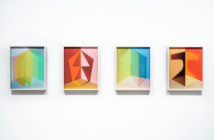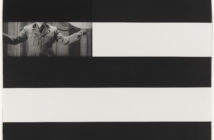Corey Escoto’s current solo show at Samsøn Projects, “A Routine Pattern of Troubling Behaviour,” is far more than at first meets the eye. When I walked into the gallery, a spare white rectangle, the works seemed quiet and unassuming. Until I stepped closer.

Corey Escoto, "Know It All," 2015. Impossible Silver Shade Film (polaroid), 8 X 14 inches with pull tab.
From the very first piece, “Know It All” (2015, Impossible Silver Shade Instant Film, 19.24” x 24.5” framed), from title alone I couldn’t help but make reference to POTUS 45. The image appears gritty in sepia tones, the text glowing, with what appears to be a pen on a string in the background. Next up (same materials and dimensions, as with all six works in this section): “The Fool.” And then “The Plot Thickens.” Russia, anyone? “Hail Mary’s & Our Father’s” (VPOTUS), “Smoke and Mirrors”–and so forth. Did Escoto have any idea how prescient these works would be?
So to say that art, especially contemporary art, exists and is shown in a silo of like-minded gallery aficionados is to ignore the fact that, to the contrary, art was, is, and will continue to be an arbiter of the zeitgeist, a voice of the times.
Corey Escoto nailed it.
But first a note on process: Escoto’s Polaroids, described in the gallery’s printed materials as “analog photographic works,” are singular. This, of course, is what makes Polaroids so compelling, as each image is unique and cannot be duplicated from a negative (or digital original). As with today’s resurgence of vinyl, it is not surprising that such vintage technology would resurface, sort of like bellbottoms. Is that in itself a statement? Of course; this process gives the artist a blank slate upon which to imprint his artistic vision and at the same time, he must trust the process as integral to the resulting artwork.

Corey Escoto, "Into the Horizon (Double Domino)," 2015. Fuji Color Instant Film, 4 X 5 inches.
Escoto uses light-blocking stencils in a sequence of partial exposures to create each piece. Multiple exposures from multiple photographic sources become a single image, described in the gallery’s printed materials as “a controlled, yet blind, guesswork of time and placement.”
So that, when we look closely at each of the smaller 4” x 5” prints in particular (there are eight in all), we see more than a static, two-dimensional image. Understanding the process, or attempting to, allows us to go deeper. For instance, in “Sky Diamond (Canary)” (2013, Fuji Color Instant Film), a geometric diamond floats like a B-movie UFO above a barely discernible coastal scene; a thumb of land juts into the water, light plays upon its surface. How Escoto pulled this off is beyond my technical ken—aforementioned explanation aside—but the result is provocative, more so because of the work’s singularity.

Corey Escoto, "Nightlight Arrangement 3 (Billions, Booed, Brick and Mortar)," 2017. Cast resin, enamel paint, LED and incandescent lights, electrical outlet molding, 54.5 X 42.5 inches.
Taken as a whole, do these images stand as unique symbols or statements, do they tell a story or both? Which brings us to the artist’s “Nightlight Arrangements.” On first glance, these seem a sort of ready-made meets Dada. Mass-produced articles—power strips—are affixed with phrases and objects created from resin in seemingly nonsensical combinations. This kind of expression is not new (or even, in this case, an entirely accurate comparison—the images actually do make sense), but then neither are Polaroids; Escoto’s vision and point of view are what make them original. Let’s throw in a bit of modernism—functionality—and plug them in for a good night’s (and bogeyman free) sleep.
But there is far more here, once again, than it seems, inviting us to question: What is true? What illusions are we clinging to? In “Nightlight Arrangement 3” (2017, cast resin, enamel paint, LED and incandescent lights, electrical outlet molding, 54.4” x 42.5”), the words are suggestive: BOOED OFF STAGE, and BILLIONS AND BILLIONS—as are the images driving them home: A padlock suggests the shutting down of free expression; the green crescent moon makes reference to science—its revelations called into question by an alarming but vocal minority.
As Escoto himself states, his nightlight sculptures are intended to “hone in on the internal light of one’s fear, of hope, and of disorientation, a turn toward and re-acquaintance [to]what it means to feel, not so much [to]think.” This sums up precisely today’s political climate.
Escoto’s work is already included in several museum collections, including those of the MIT List Visual Arts Center, the Carnegie Museum of Art in Pittsburgh, and Museum of Contemporary Art Chicago. I suspect there will be many more as his work continues to travel the country.
“A Routine Pattern of Troubling Behaviour” is on view through April 1 at Samsøn Projects, 450 Harrison Avenue/29 Thayer Street, Boston. Call 617-357-7177 or visit samsonprojects.com for further information.
- Corey Escoto, “Nightlight Line Strip Arrangement 1 (This pain, I feel you),” 2017. Cast resin, enamel paints, LED and incandescent lights, electrical outlet molding, 9 X 42 inches.
- Corey Escoto, “Nightlight Arrangement 3 (Billions, Booed, Brick and Mortar),” 2017. Cast resin, enamel paint, LED and incandescent lights, electrical outlet molding, 54.5 X 42.5 inches.
- Corey Escoto, “Smoke and Mirrors,” 2016. Impossible Silver Shade Instant Film (polaroid), 8 X 14 inches with pull tab.
- Corey Escoto, “Know It All,” 2015. Impossible Silver Shade Film (polaroid), 8 X 14 inches with pull tab.
- Corey Escoto, “Hoofs n’ Heels,” 2013. Fuji Color Instant Film, 4 X 5 inches.
- Corey Escoto, “ACLU Nightlight,” 2017. Cast resin, enamel paint, LED light. Edition of 100. 6 X 4.5 inches.
- Installation view, “A Routine Pattern of Troubling Behaviour,” Corey Escoto. Courtesy Samson Projects.
- Corey Escoto, “Into the Horizon (Double Domino),” 2015. Fuji Color Instant Film, 4 X 5 inches.
- Corey Escoto, “Good Folk,” 2015. Fuji Color Instant Film, 4 X 5 inches.
- Corey Escoto, “Front Page News,” 2015. Impossible Silver Shade Instant Film (polaroid), 8 X 14 inches with pull tab.
- Corey Escoto, “Approach the Bench,” 2014. Fuji Color Instant Film, 4 X 5 inches.















